In higher elevations, it snowed and the leaves are beginning to drop from the trees.
Autumn colors in Japan (Japanese version only):
http://kouyou.yahoo.co.jp/
http://kouyou.nihon-kankou.or.jp/
http://koyo.walkerplus.com/
http://www.mapple.net/sp_koyo/
The Deer Antler Cutting Ceremony was held at Nara Park in Nara Prefecture on October 12th and 14th. Although male deer shed their antlers before winter and grow them back in spring every year, the event started in 1671 to prevent antlered deer from injuring people or another deer. They have no pain because nerves are not located in the mature antler. Antlers are dedicated to the deity. This event is held in accordance with ancient ritual, but the antlers of about 250 deer in Nara Park are cut from the end of August through March.
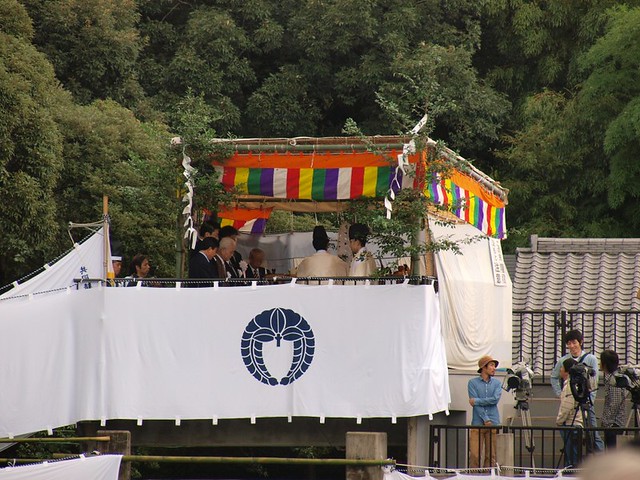 |
| 1_large by merec0 /flickr |
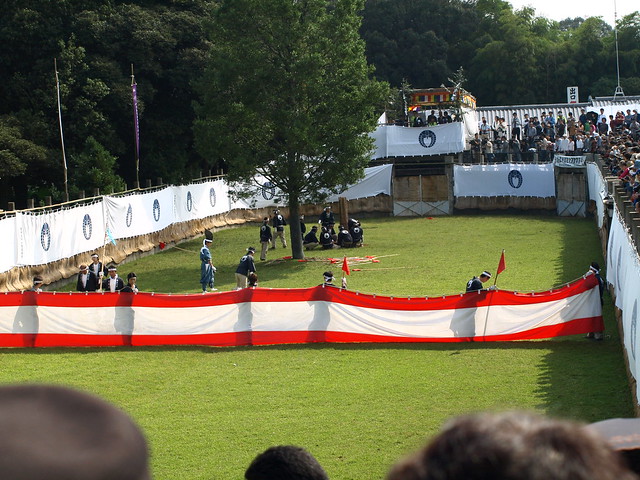 |
| PA112472 by merec0 /flickr |
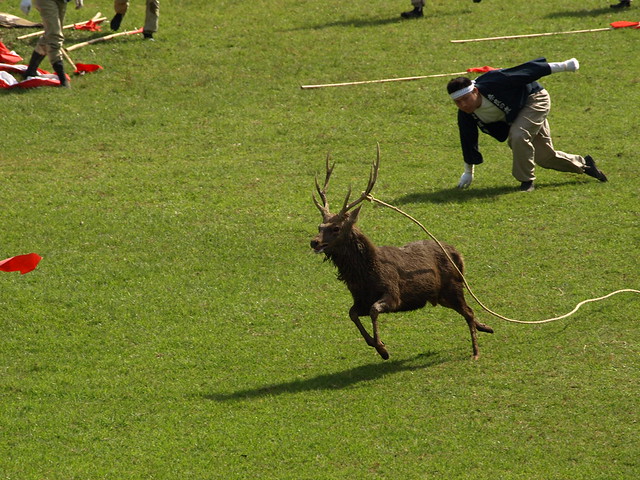 |
| PA112495 by merec0 /flickr |
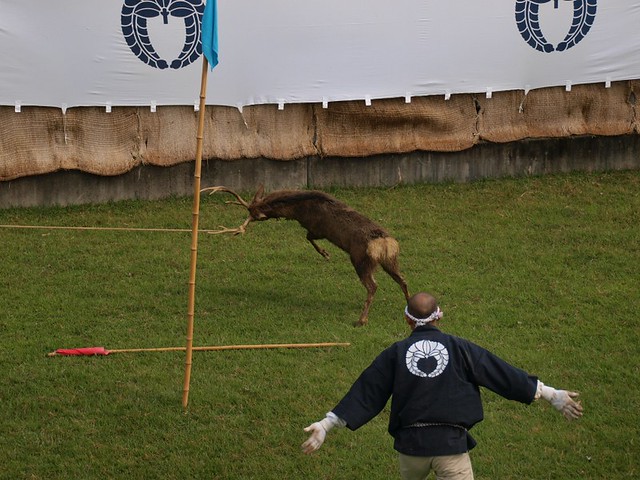 |
| 182_large by merec0 /flickr |
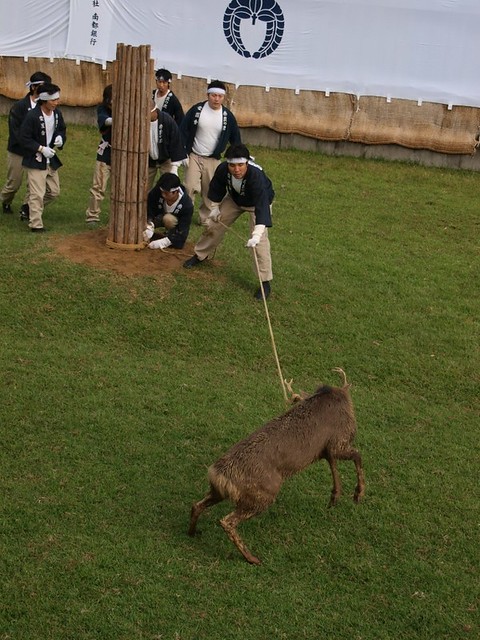 |
| 188_large by merec0 /flickr |
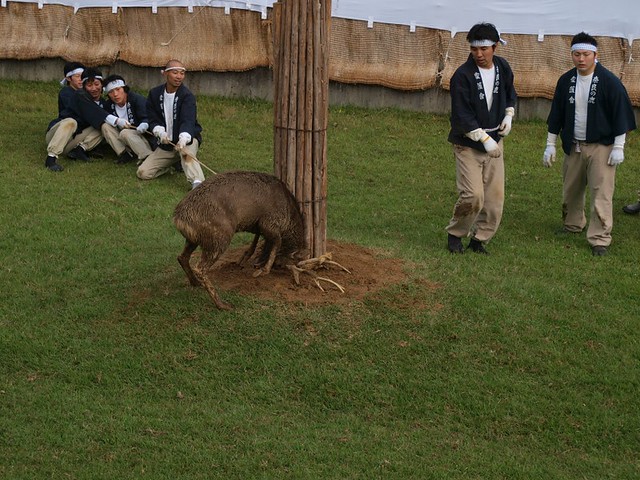 |
| 198_large by merec0 /flickr |
 |
| 204_large by merec0 /flickr |
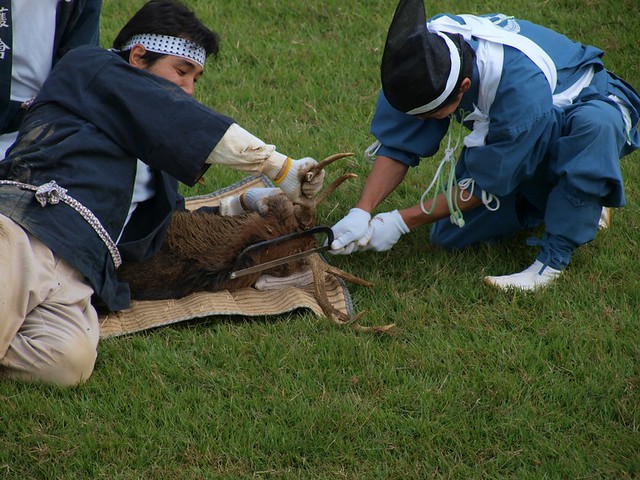 |
| 237_large by merec0 /flickr |
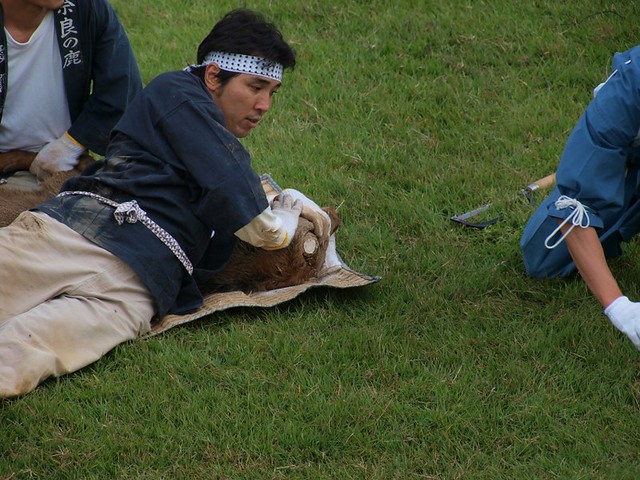 |
| 277_large by merec0 /flickr |
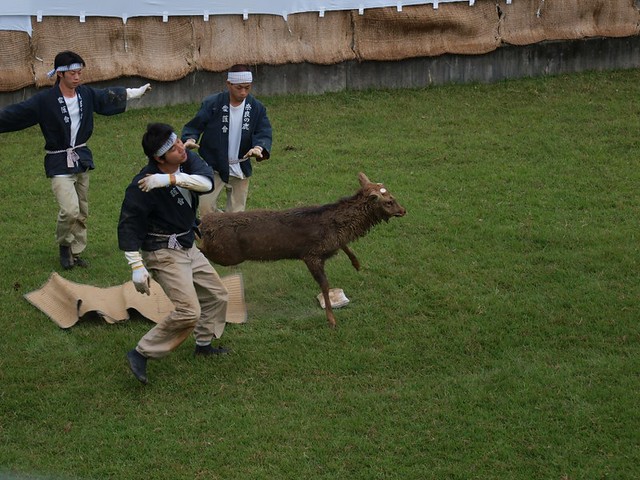 |
| 287_large by merec0 /flickr |
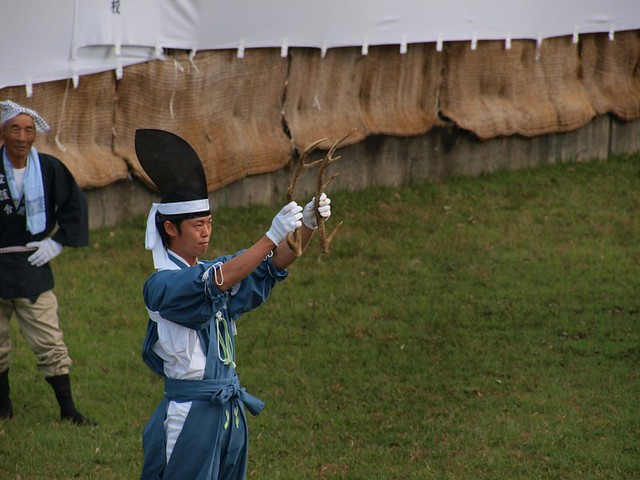 |
| 164_large by merec0 /flickr |
 |
| around five-storied pagoda in Kofuku-ji Temple photo by euzim.net |
Visitors can see many deer around Nara Park. They are unafraid of humans, but they are wild animals. It's dangerous to come close to male deer in estrus and mother deer with fawns.
 |
| around five-storied pagoda in Kofuku-ji Temple photo by euzim.net |
Their staple food is the native plants around the park. Many deer died of the human foods that tourists gave to them or of plastic food packages that tourists threw away. We are not allowed to feed them. The park has no garbage to prevent deer from accidentally eating them.
 |
| at Todai-ji Temple photo by euzim.net |
 |
| at Todai-ji Temple photo by euzim.net |
 |
| IMG_3825 by tetchang /flickr Shika-senbei |
Only Shika-senbei(cracker containing rice bran and cereals) is sold as a snack by Foundation For The Protection Of Deer In Nara. The foundation is engaged in protection activity for them. A part of earnings from these cracker sales are used to protect deer.
The foundation operates Rokuen (Deer enclosure) for sick or injured deer, bucks that have potential for harming humans, aggressive rutting bucks, pregnant does and does with fawns. This facility was closed to the public, but the foundation turned to open it to convey to visitors the real state of deer in Nara last year.
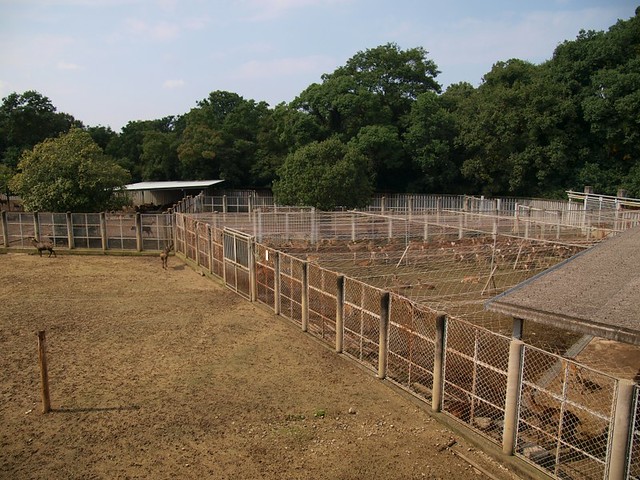 |
| 293_large by merec0 /flickr |
Fawns are born in late May to early July at Rokuen in Nara Park. Visitors can see fawns for only a few hours from June 1 to 30 at Rokuen. Mother deer and fawns return to the park around mid-July. Mother deer are wary of human smells. It is best not to touch fawns.
 |
| kensai_kodak_eb-3_217s by yingtak /flickr |
For more information about Foundation for the Protection of Deer in Nara:
http://www.naradeer.com/ (Japanese version only)
The foundation announced that 1,094 deer live in Nara Park and Mount Wakakusa as of July 16, 2013. They include 210 bucks, 736 does, 148 fawns. In one year, 100 deer had died of traffic accident, 144 had died of disease, and 115 had died from other causes.
They have been designated as a national natural treasure. The deer is regarded as a messenger of the deities at the Kasuga Grand Shrine (春日大社, Kasuga-taisha). They have been living there since before the shrine was built in 768.
The shrine invited Takemikazuchi-no-mikoto(the deity of thunder, the deity of war) from Kashima Jingu Shrine (鹿島神宮) in Ibaraki Prefecture as an enshrined deity of the Kasuga Grand Shrine. According to the legend, the divided spirit of Takemikazuchi rode a white deer to Nara with many deer.
At Kashima Shrine, the deer is regarded as a messenger of the deities because deer sent the message from Amaterasu(an enshrined deity of Ise Shrine) to Kashima Shrine's deity. There are about 30 deer in a deer garden of the Kashima Shrine.
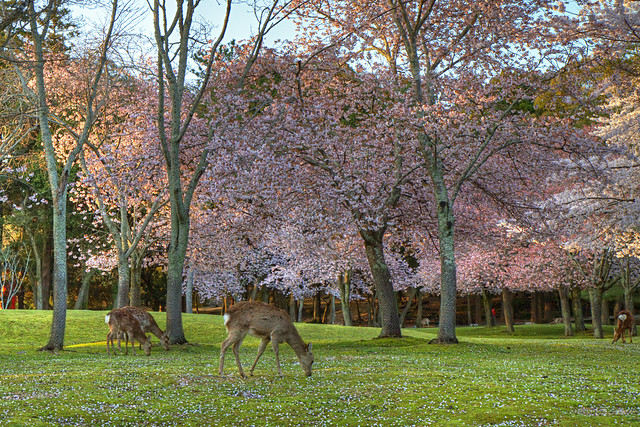 |
| IMG_4551_Enhancer by fortherock /flickr |
From February to mid-March, Shikayose(Herding Deer by Blowing a Horn) is held at Tobuhino(飛火野) in Nara Park. When a player blows a horn, a herd of wild deer comes running up to the player to get acorns. The annual event started to herd deer in 1892 when a deer shelter was built in Nara Park.
Shikayose was held several times in July and August this year.
Except during the above period, visitors can enjoy this event for fee. Advance reservation is required.
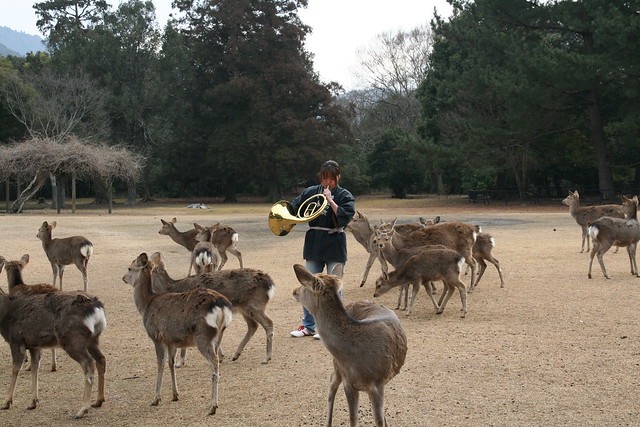 |
| 奈良の鹿寄せ 2011 - 02 by Sekikos /flickr Shikayose |
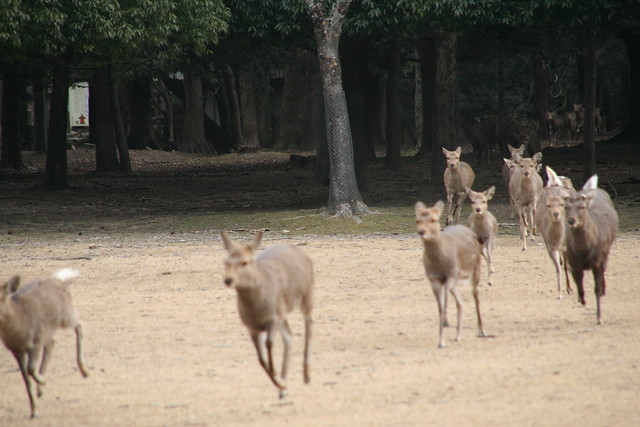 |
| 奈良の鹿寄せ 2011 - 04 by Sekikos /flickr Shikayose |
 |
| 奈良の鹿寄せ 2011 - 08 by Sekikos /flickr Shikayose |
The Deer Antler Cutting Ceremony was also held at Kinkasan in Miyagi Prefecture on October 6.
Kinkasan (金華山, Kinkasan or Kinkazan) is a small sacred island off the Oshika Peninsula in Miyagi Prefecture. The island is covered with primeval forest. Wild deer and monkeys live there.
 |
| Deer Antler Cutting Ceremony at Kinkasan photo by Miyagi Prefecture Tourism Division |
 |
at Kinkasan
photo by Miyagi Prefecture Tourism Division |
About 500 wild deer live there. The deer have been regarded as the messengers of a deity, so they are wandering around the shrine. After the antlers of about 15 bucks are cut, they have a medical checkup. Some people say that they are kind of shy compared with deer in Nara.
Even throughout Japan, deer overpopulation is a serious problem. They feed on crops, garden plants and kill forest trees by feeding on young trees and the bark of trees, by rubbing antlers against trees.
A media reported on November 12 in 2012 that Nara Prefecture was considering to decrease the number of deer. Many people have strongly protested against the elimination of the deer.
Some people say that the Japanese deer should be exterminated to protect the environment from the deer. The prefecture was thinking about ways to reduce deer feeding damage, but deferred discussion on the matter.
Most longtime residents in Nara don't make a complaint about deer. Though they eat crops, plants in personal gardens, and trample on a flowerbed in a university near the park. The prefecture has received more complaints from newcomers.
Miyajima(Itsukushima) is an island in Hatsukaichi City, Hiroshima Prefecture. Itsukushima Shrine (厳島神社) on the island has been registered on the World Heritage List (cultural part) in 1996.
Some people say that deer have lived in Miyajima for 6,000 years. The natural foods supply has been limited in the island. They had searched for food by moving round the island. Only a few deer populations remained there. Miyajima residents cherished the deer as a messenger of a deity. They tried to increase their deer population. It has increased tremendously since the 1970s when a boom in tourism had taken place. They lost their natural wildness and got used to human habitats because tourists fed them human food. They may get sick, die or become malnourished due to human food. They have had negative effects on biodiversity in the woods near the town.
Hatsukaichi City urges tourists not to feed deer human food. The city tries to get them back to where they should be. Some people say that skinny deer are more common in Miyajima. Unable to stand by any longer, they feed starving deer acorns.
deer in Miyajima
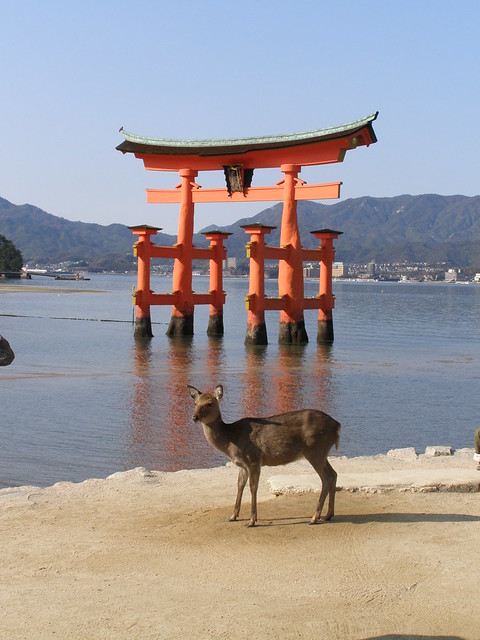 |
| Deer Tori by xxspecialsherylxx /flickr |
Yezo deer (Cervus nippon yesoensis) are indigenous to Hokkaido. The number of the deer has recently increased drastically. Their increasing numbers have caused a large number of deer-vehicle traffic accidents, have damaged to food crops, and have had negative effects on biodiversity. For now, hunting is the best way to control deer populations. The Hokkaido government is encouraging people not only to hunt but also to eat venison. We are unfamiliar with venison.
 |
| Yezo deer |
Kanoko(鹿の子) means a fawn. Kanoko pattern(white‐spotted pattern) was named after the fawn's spots although mother deer also have the pattern.
"Kanoko shibori" is one of the methods of tie-dyeing cloth regularly patterned like the fawn's spots. Shibori includes a number of labor-intensive resist techniques including stitching elaborate patterns and tightly gathering the stitching before dyeing, forming intricate designs for kimonos.
Kanoko is also the name of a Japanese confection.
obiage(帯揚げ) of complete tie-dyeing
Obiage is a scarf-like piece of cloth that covers up the obimakura(a small oval cushion) for keeping the upper part of the obi knot in place. Obiage is tucked into top of obi and is relatively big when kimono is dressed up.
tie-dyed bag
 |
| Kimono enchantment by br1dotcom /flickr |
Hanafuda (花札) is a Japanese card game with 48 cards. The name literally means "flower cards." It comes from the Portuguese word "carta" that came down to Japan in the 16th century. There are twelve suits. Each suit has four cards with a design representing each of the twelve months.
One card of Hanafuda--deer and maple in the tenth month of the year(in the lunar calendar)
The design of this card comes from the following waka poem by Sarumaru no Taifu(猿丸大夫). He was a waka poet in the eighth or ninth century, and is also known as Sarumaru Dayu. His date of birth and death is unknown.
奥山に もみぢ踏みわけ 鳴く鹿の
声きく時ぞ 秋は悲しき
O-ku-ya-ma-ni Mo-mi-ji-fu-mi-wa-ke Na-ku-shi-ka-no
Ko-we-ki-ku-to-ki-zo A-ki-wa-ka-na-shi-ki
Deep in the mountains, a deer makes his way through fallen maple leaves bleating for his wife.
His long plaintive cry brings on feelings of melancholy.
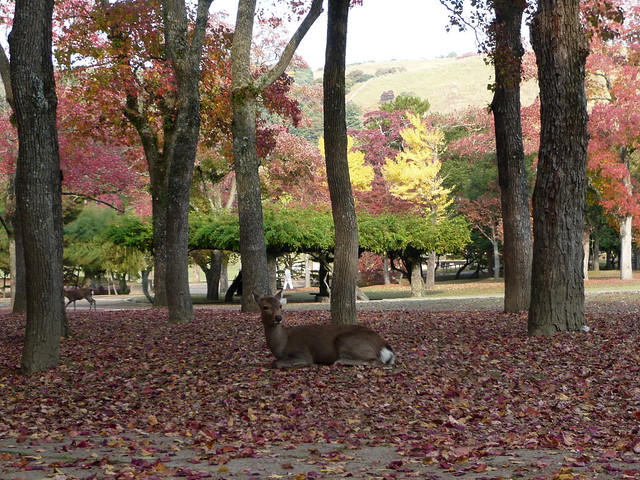 |
| Deer in the trees by WordRidden /flickr |





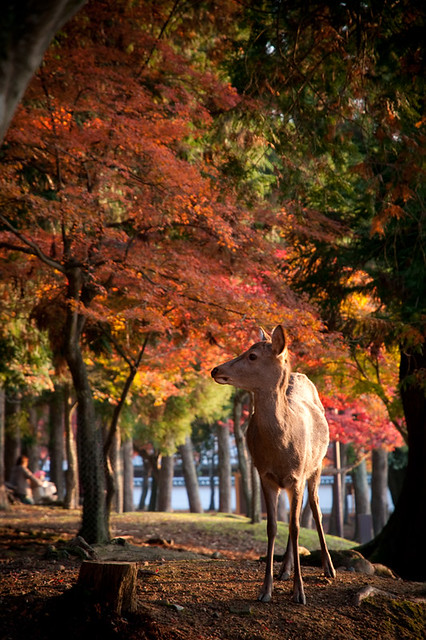
Wow, I never knew all these things about deer in Japan. I only knew the deer seemed to be all over the place in Nara! Thank you for so much information.
ReplyDeleteThank you for your comment. The deer in Nara are famous internationally, but many people don't seem to know why many deer live in Nara.
Delete